stICQ is an ICQ client for mobile phones with symbian OS.
StICQ has been written by Russian programmer Sergey Taldykin. StICQ is a native Symbian application (.SIS) for instant messaging over Internet for the ICQ network (using the OSCAR protocol).
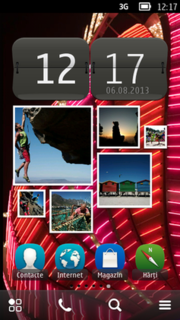
Symbian is a discontinued mobile operating system (OS) and computing platform designed for smartphones. Symbian was originally developed as a closed-source OS for PDAs in 1998 by the Symbian Ltd. consortium. Symbian OS was a descendant of Psion's EPOC, and ran exclusively on ARM processors, although an unreleased x86 port existed. Symbian was used by many major mobile phone brands, like Samsung, Motorola, Sony Ericsson, and above all by Nokia. It was also prevalent in Japan by brands including Fujitsu, Sharp and Mitsubishi. As a pioneer that established the smartphone industry, it was the most popular smartphone OS on a worldwide average until the end of 2010—at a time when smartphones were in limited use—when it was overtaken by Android, as Google and its partners achieved wide adoption. It was notably not as popular in North America.

ICQ is a cross-platform instant messaging and VoIP client. The name ICQ derives from the English phrase "I Seek You". Originally developed by Mirabilis in 1996, the client was bought by AOL in 1998, and then by Mail.Ru Group in 2010.
OSCAR is AOL's flagship instant messaging and presence information protocol. It was used by AOL's AIM instant messaging system and ICQ.
It supports all main statuses including "Not Available", "Invisible" etc., contact search using ICQ UID, black lists, multi-user support, sound announcements and even SMS sending using default ICQ server.
It is featured by small size, low memory usage and relatively stable work.
One of the key features of the client is its ability to suspend outcoming data until GPRS coverage is available. It also suspend the status of the user, while all other mobile clients (Jimm, for instance) usually report connection problem and drop user out.
Jimm is an alternative open-source instant messaging client for ICQ network. It is written in Java ME and should work in most of mobile devices that follow MIDP specification.
Currently, stICQ does not support smiley pictures but have a unique feature of quick emoticon input using the call button (special plugin required).

A smiley is a stylized representation of a smiling humanoid face that is a part of popular culture worldwide. The classic form designed by Harvey Ball in 1963 comprises a yellow circle with two black dots representing eyes and a black arc representing the mouth On the Internet and in other plain text communication channels, the emoticon form has traditionally been most popular, typically employing a colon and a right parenthesis to form sequences such as :-), :), or (: that resemble a smiling face when viewed after rotation through 90 degrees. "Smiley" is also sometimes used as a generic term for any emoticon. The smiley has been referenced in nearly all areas of Western culture including music, movies, and art. The smiley has also been associated with late 1980s and early 1990s rave culture.

An emoticon, short for "emotion icon", also known simply as an emote, is a pictorial representation of a facial expression using characters—usually punctuation marks, numbers, and letters—to express a person's feelings or mood, or as a time-saving method. The first ASCII emoticons, :-) and :-(, were written by Scott Fahlman in 1982, but emoticons actually originated on the PLATO IV computer system in 1972.
Notable, stICQ supports the yellow "Ready to chat" extended status while "Depressive", as well as "At home", "At work" etc. are displayed as "Offline". This caused to call stICQ an "anti-depressive ICQ".
The source code has been sold to the development team of Quiet Internet Pager messenger. 1.01 version QiP for Symbian has been released recently.

QIP is a multiprotocol instant messaging client. It is a closed source freeware program originally developed by Ilgam Zyulkorneev. In 2008 it was bought by RosBusinessConsulting media group and named most popular RBC service in 2009.
StICQ is free for download, as are wide variety of mods changing status icons and menu text.
Modding is a slang expression that is derived from the verb "modify". Modding refers to the act of modifying hardware, software, or virtually anything else, to perform a function not originally conceived or intended by the designer, or achieve a bespoke specification. The term modding is used within the computer game community, particularly in regard to creating new or altered content and sharing that via the web. It may be applied to the overclocking of computers in order to increase the frequency at which the CPU operates. Case modding is a popular activity amongst many computer enthusiasts which involves the customization of a computer case or the installation of water cooling technology. In connection with automobiles, modding can mean engine tuning, remapping of a vehicle's engine control unit or customization of the bodywork. Some people modify small electronic handheld toys by circuit bending, changing the circuits and adding a knob or switch that will change the produced pitch up or down.
Trillian is a proprietary multiprotocol instant messaging application created by Cerulean Studios. It is currently available for Microsoft Windows, Mac OS X, Linux, Android, iOS, BlackBerry OS, and the Web. It can connect to multiple IM services, such as AIM, Bonjour, Facebook Messenger, Google Talk (Hangouts), ICQ, IRC, XMPP (Jabber), VZ, and Yahoo! Messenger networks; as well as social networking sites, such as Facebook, Foursquare, LinkedIn, and Twitter; and email services, such as POP3 and IMAP.
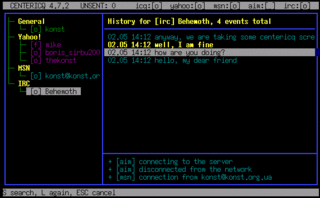
Centericq is a text mode menu- and window-driven instant messaging interface that supports the ICQ, Yahoo!, AIM, MSN, IRC, XMPP, LiveJournal, and Gadu-Gadu protocols. It allows you to send, receive, and forward messages, URLs, SMSes, contacts, and email express messages, and it has many other useful features. Known to work in Linux, FreeBSD, NetBSD, OpenBSD, Solaris, Windows and macOS/Darwin Operating Systems.
The current landscape for instant messaging involves cross-platform instant messaging clients that can handle one or multiple protocols so that internet users can communicate with multiple users at the same time. The following tables compare general and technical information for a number of instant messaging clients. See the individual products' articles for further information. External links may lead to extensions that add a feature to a client.

Google Talk was an instant messaging service that provided both text and voice communication. The instant messaging service is colloquially known as "Gchat", "Gtalk", or "Gmessage" to its users.

Skype for Business Server is real-time communications server software that provides the infrastructure for enterprise instant messaging, presence, VoIP, ad hoc and structured conferences and PSTN connectivity through a third-party gateway or SIP trunk. These features are available within an organization, between organizations and with external users on the public internet or standard phones.
Mobile malware is malicious software that targets mobile phones or wireless-enabled Personal digital assistants (PDA), by causing the collapse of the system and loss or leakage of confidential information. As wireless phones and PDA networks have become more and more common and have grown in complexity, it has become increasingly difficult to ensure their safety and security against electronic attacks in the form of viruses or other malware.
Push email is an email system that provides an always-on capability, in which new email is actively transferred (pushed) as it arrives by the mail delivery agent (MDA) to the mail user agent (MUA), also called the email client. Email clients include smartphones and, less strictly, IMAP personal computer mail applications.
The Danger Hiptop and Danger Hiptop2 devices come with a variety of included software titles.
Mobiola is a wide range of software by SHAPE Services.

Nokia PC Suite is a software package used to establish an interface between Nokia mobile devices and computers that run the Microsoft Windows operating system. Its first release was in 1997, originally called Nokia Data Suite. It was replaced by Nokia Suite and integrated into the Ovi service suite.
An SMS gateway allows a computer to send or receive Short Message Service (SMS) transmissions to or from a telecommunications network. Most messages are eventually routed into the mobile phone networks. Many SMS gateways support media conversion from email and other formats.
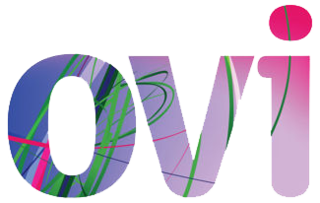
Ovi by Nokia was the brand for Nokia's Internet services. The Ovi services could be used from a mobile device, computer or via the web. Nokia focused on five key service areas: Games, Maps, Media, Messaging and Music. Nokia's aim with Ovi was to include third party developers, such as operators and third-party services like Yahoo's Flickr photo site. With the announcement of Ovi Maps Player API, Nokia started to evolve their services into a platform, enabling third parties to make use of Nokia's Ovi services.

MSN Messenger, later rebranded as Windows Live Messenger, was a cross-platform instant messaging client developed by Microsoft. It connected to the Microsoft Messenger service while also having compatibility with Yahoo! Messenger and Facebook Messenger. The client was first released as MSN Messenger Service on July 22, 1999, and was marketed under the MSN branding until 2005 when it was rebranded under Windows Live and has since been officially known by its present name, although its previous name was still used colloquially by most of its users. In June 2009, Microsoft reported the service attracted over 330 million active users each month, placing Messenger among the most widely used instant messaging clients in the world.
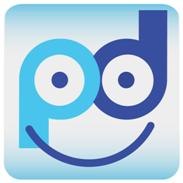
PicDial is a mobile service created by IQzone Inc. and based in Scottsdale, Arizona, United States. PicDial provides users with the ability to automatically see their friends' Facebook and MySpace profile pictures and status messages as Full Screen Caller ID on their mobile phone. The software automatically keeps contacts social networking information current, allowing the most recent profile pictures and status messages to be displayed on incoming and outgoing calls or texts. The PicDial application provides users with a "Favorites Screen," a visual grid that allows users to call or text by selecting a friends social networking profile picture. This Mobile social address book platform allows users to link multiple social networks. The application also enables users to determine which picture will display when a call or text is made to a PicDial friend, giving the user control over the picture seen by friends. This defined picture can either be taken from the users camera on the phone, or pulled from their profile pictures on Facebook or MySpace. When a user changes their picture, this new image will be updated to their friends' phones.

uTalk is a free client for messaging between phones and computers. With uTalk you can send free pictures, voice and text to your friends from any social network, chat in groups, and view your friends locations. uTalk supports various protocols such as AIM, Yahoo! Messenger, Windows Live Messenger, XMPP/Jabber, Vkontakte, Odnoklassniki, Google Talk, Gadu-Gadu, ICQ, MobileMe/iChat and Facebook.
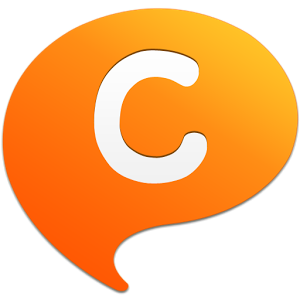
ChatON was a global mobile communication service introduced by Samsung Electronics in September 2011. ChatON served more than 120 countries in 62 languages. ChatON was available on Android, iOS, BlackBerry, Windows Phone, Windows Mobile (Korea), and Bada smartphones. Additionally, a web client was offered for access to the service via web browsers. Users could invite and register buddies via Facebook and Twitter as well as share ChatON content on Facebook. Among ChatON's unique features were allowing users to create Animation messages, Broadcast to send personal notices in a group chat room, and the Trunk which stores media files shared in chats. When a user logs in ChatON, the users' buddy list is available on any connected device.
Microsoft Mobile Services are a set of proprietary mobile services created specifically for mobile devices, they are typically offered through mobile applications and mobile browser for Windows Phone, Android, iOS, BlackBerry, Nokia /block/deny/405platforms, BREW, and Java ME. Microsoft's mobile services are typically connected with a Microsoft account and often come preinstalled on Microsoft's own mobile operating systems while they are offered via various means for other platforms. Microsoft started to develop for mobile computing platforms with the launch of Windows CE in 1996 and later added Microsoft's Pocket Office suite to their Handheld PC line of PDAs in April 2000. From December 2014 to June 2015, Microsoft made a number of corporate acquisitions, buying several of the top applications listed in Google Play and the App Store including Acompli, Sunrise Calendar, Datazen, Wunderlist, Echo Notification Lockscreen, and MileIQ.
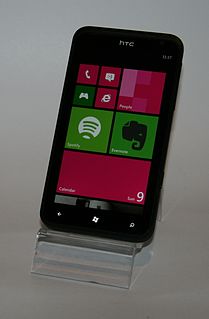
Windows Phone 7 is the first release of the Windows Phone mobile client operating system, released worldwide on October 21, 2010, and in the United States on November 8, 2010. It received multiple large updates, the last being Windows Phone 7.8, which was released in January 2013 and added a few features backported from Windows Phone 8, such as a more customizable start screen.












